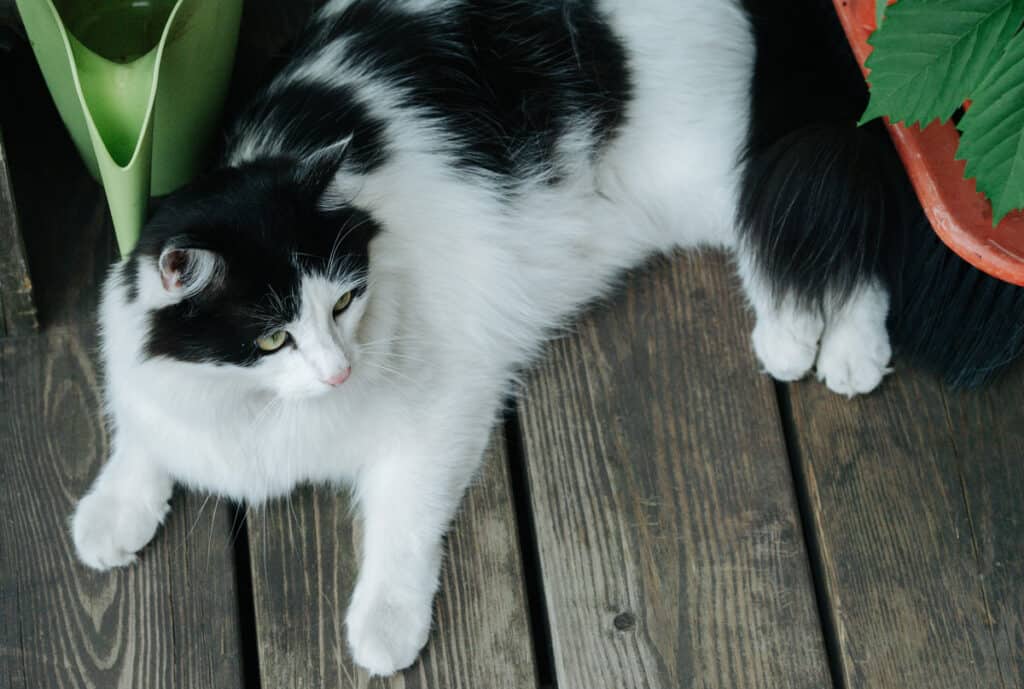A harlequin cat is a type of bicolor (or piebald) and tricolor coat pattern found on some domestic cats. This coat pattern is predominately white fur with spots of another color dispersed over the head and body.
The classification of a bicolor cat coat pattern is dependent on the ratio of white to color fur. Cats can be categorized by the following white spotting scale:
- Low-grade: less than 40% of the cat’s coat is white
- Medium-grade: 40-60% of the coat is white
- High-grade: more than 60% of the coat is white
According to cat fancier organization Fédération Internationale Féline, harlequin cats should be between 50% – 75% white with color patches that are predominately on the body and a solid color tail. Some color patches may be on the face.
Harlequin cats can also be tricolor (such as patches of calico fur colors) where white is still the dominant color and the two other colors are contained together in the same patches.
The tail of the harlequin cat is always entirely the same color or coat pattern as the patches on the cat.
Why are they called harlequin cats?
The term “harlequin” is borrowed from a character that was introduced in 16th century Italian Commedia dell’arte, who was known for his checkered costume. In feline terms, a Harlequin cat is predominantly white with patches of color covering no more than 1/3 of its body.

These colored patches can be any hue – black, gray, orange, cream, or even a tortoiseshell or calico pattern. The randomness of these patches creates a unique pattern for each Harlequin cat.
Are harlequins a breed of cats?
The term “Harlequin” doesn’t refer to a specific breed but is a color pattern that can appear in any breed or mix of breeds.
Black and white harlequin cats
Harlequin cats with black spots are commonly known as “cow cats” or “moo cats” given the patterns similarity to Holstein-Friesian dairy cows.

Types of Color Combinations for Harlequin Cats
White cats with random black patches is one of the more common iterations of the harlequin coat pattern. Harlequin cats can have other white and color combinations including:
- Chocolate (brown) and white
- Cinnamon (light brown) and white
- Red and white
- Blue (gray) and white
- Lilac (lavender) and white
- Fawn and white
- Cream and white
- Calico (tricolor)
- Tabby markings
Calico Harlequin Cat
Harlequin coat patterns can be seen in cats with tabby and calico colors.
Harlequin cats with a calico coat pattern have large areas of their bodies that are white coupled with patches of black, orange, and sometimes a dilute blue or cream, the typical colors of a calico. The tail of a harlequin cat continues the calico patches of orange and black.

Harlequin cat with tabby coat pattern
These harlequin cats have a predominant white color with patches of tabby-patterned fur.
The tabby patches on a harlequin cat can be any of the classic tabby patterns – mackerel, classic, spotted, or ticked – and display the typical tabby markings such as stripes, swirls, or spots in patches that stand out against the mostly white coat of the cat.

Cat Breed That Can Have a Harlequin Coat Pattern
The following are some of breeds can have a harlequin coat pattern:
- British Shorthair
- Colorpoint Shorthair
- Maine Coon
- Munchkin Cat
- Japanese Bobtail
- Persian Cat
- Turkish Van

Coat Patterns Similar to Harlequin Cats
Mask and Mantle Coat Pattern
The “mask and mantle cat” coat pattern looks similar to a harlequin cat coat pattern. However, the coat pattern for mask-and-mantle cats has a greater proportion of color to white ratio.
The majority of the head and along the backside of a cat with this coat pattern is colored, making the cat look like they have a “mask and cape”.
Mask and mantle coat patterns have medium-white coat spotting.

Cap-and-Saddle
With the cap and saddle coat pattern, the amount of color shrinks to a smaller patch on the lower back and a less color on the head compared to a mask and mantle coat cat pattern.

The name ‘cap-and-saddle’ comes from the two primary areas of color that these cats exhibit on their largely white bodies: a colored “cap” on the top of the head, and a colored “saddle” patch on the back, usually around the tail area. Apart from these areas, the rest of the body is usually entirely white.
This article was originally written on May 13, 2022 and has since been updated.







